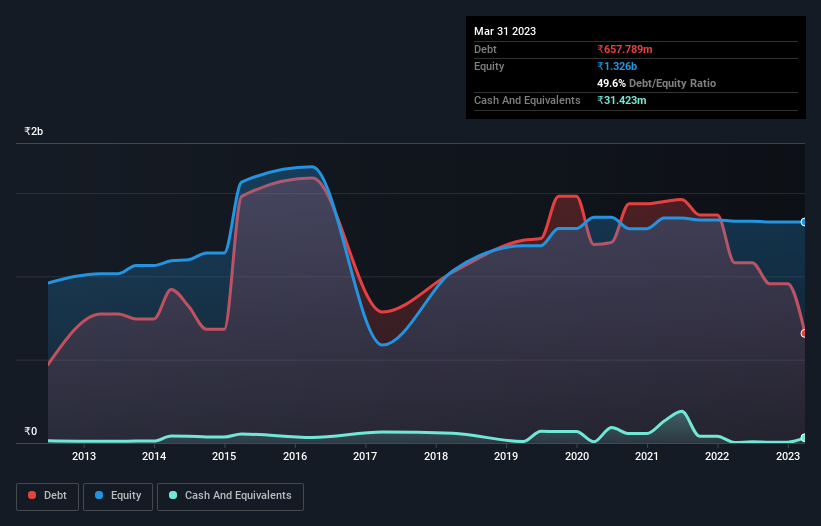Warren Buffett famously said, 'Volatility is far from synonymous with risk.' So it might be obvious that you need to consider debt, when you think about how risky any given stock is, because too much debt can sink a company. We note that Nila Infrastructures Limited (NSE:NILAINFRA) does have debt on its balance sheet. But should shareholders be worried about its use of debt?
What Risk Does Debt Bring?
Debt is a tool to help businesses grow, but if a business is incapable of paying off its lenders, then it exists at their mercy. Ultimately, if the company can't fulfill its legal obligations to repay debt, shareholders could walk away with nothing. However, a more usual (but still expensive) situation is where a company must dilute shareholders at a cheap share price simply to get debt under control. Of course, the upside of debt is that it often represents cheap capital, especially when it replaces dilution in a company with the ability to reinvest at high rates of return. When we think about a company's use of debt, we first look at cash and debt together.
View our latest analysis for Nila Infrastructures
What Is Nila Infrastructures's Debt?
You can click the graphic below for the historical numbers, but it shows that Nila Infrastructures had ₹657.8m of debt in March 2023, down from ₹1.08b, one year before. However, because it has a cash reserve of ₹31.4m, its net debt is less, at about ₹626.4m.

How Healthy Is Nila Infrastructures' Balance Sheet?
We can see from the most recent balance sheet that Nila Infrastructures had liabilities of ₹6.57b falling due within a year, and liabilities of ₹284.7m due beyond that. Offsetting this, it had ₹31.4m in cash and ₹352.5m in receivables that were due within 12 months. So it has liabilities totalling ₹6.47b more than its cash and near-term receivables, combined.
This deficit casts a shadow over the ₹2.56b company, like a colossus towering over mere mortals. So we'd watch its balance sheet closely, without a doubt. After all, Nila Infrastructures would likely require a major re-capitalisation if it had to pay its creditors today.
In order to size up a company's debt relative to its earnings, we calculate its net debt divided by its earnings before interest, tax, depreciation, and amortization (EBITDA) and its earnings before interest and tax (EBIT) divided by its interest expense (its interest cover). Thus we consider debt relative to earnings both with and without depreciation and amortization expenses.
Nila Infrastructures shareholders face the double whammy of a high net debt to EBITDA ratio (24.2), and fairly weak interest coverage, since EBIT is just 0.098 times the interest expense. The debt burden here is substantial. Worse, Nila Infrastructures's EBIT was down 81% over the last year. If earnings continue to follow that trajectory, paying off that debt load will be harder than convincing us to run a marathon in the rain. When analysing debt levels, the balance sheet is the obvious place to start. But you can't view debt in total isolation; since Nila Infrastructures will need earnings to service that debt. So when considering debt, it's definitely worth looking at the earnings trend. Click here for an interactive snapshot.
But our final consideration is also important, because a company cannot pay debt with paper profits; it needs cold hard cash. So the logical step is to look at the proportion of that EBIT that is matched by actual free cash flow. Over the last three years, Nila Infrastructures actually produced more free cash flow than EBIT. That sort of strong cash conversion gets us as excited as the crowd when the beat drops at a Daft Punk concert.
Our View
On the face of it, Nila Infrastructures's EBIT growth rate left us tentative about the stock, and its level of total liabilities was no more enticing than the one empty restaurant on the busiest night of the year. But on the bright side, its conversion of EBIT to free cash flow is a good sign, and makes us more optimistic. Taking into account all the aforementioned factors, it looks like Nila Infrastructures has too much debt. While some investors love that sort of risky play, it's certainly not our cup of tea. The balance sheet is clearly the area to focus on when you are analysing debt. However, not all investment risk resides within the balance sheet - far from it. Case in point: We've spotted 3 warning signs for Nila Infrastructures you should be aware of, and 2 of them are a bit unpleasant.
Of course, if you're the type of investor who prefers buying stocks without the burden of debt, then don't hesitate to discover our exclusive list of net cash growth stocks, today.
Valuation is complex, but we're here to simplify it.
Discover if Nila Infrastructures might be undervalued or overvalued with our detailed analysis, featuring fair value estimates, potential risks, dividends, insider trades, and its financial condition.
Access Free AnalysisHave feedback on this article? Concerned about the content? Get in touch with us directly. Alternatively, email editorial-team (at) simplywallst.com.
This article by Simply Wall St is general in nature. We provide commentary based on historical data and analyst forecasts only using an unbiased methodology and our articles are not intended to be financial advice. It does not constitute a recommendation to buy or sell any stock, and does not take account of your objectives, or your financial situation. We aim to bring you long-term focused analysis driven by fundamental data. Note that our analysis may not factor in the latest price-sensitive company announcements or qualitative material. Simply Wall St has no position in any stocks mentioned.
About NSEI:NILAINFRA
Nila Infrastructures
Nila Infrastructures Limited constructs and develops infrastructure and real estate projects in India.
Flawless balance sheet and fair value.
Market Insights
Community Narratives



